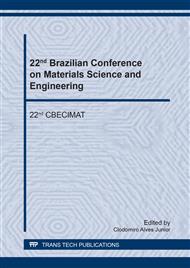p.164
p.170
p.179
p.184
p.190
p.195
p.201
p.207
p.212
Physical Properties of PHB/VMF2 Nanocomposite Microcapsules in Water
Abstract:
The characterization of nanocomposites microcapsules made of biodegradable polymers is really important to science and technology, as different systems can be produced targeting unique properties. The aim of this study is to prepare and to evaluate oil loaded PHB/VMF2 microcapsules’ behavior in water. The microcapsules were analyzed by FTIR, SEM and XRD. The biodegradable nanocomposite present exfoliated clay (XRD) whose absorption at 989 cm-1 (FTIR) indicates the Si-O stretching vibration, from VMF2. The microcapsules observed by SEM presented spherical shapes and some average diameters from 12 μm to 35 μm, depending on the composition of the shell and the presence or absence of the encapsulated oil. Compared to microcapsules’ shell made from PHB, those from the nanocomposite PHB/VMF2 proved to display better mechanical resistance thus very few fractured particles were observed by SEM.
Info:
Periodical:
Pages:
190-194
Citation:
Online since:
September 2018
Keywords:
Price:
Сopyright:
© 2018 Trans Tech Publications Ltd. All Rights Reserved
Share:
Citation:


